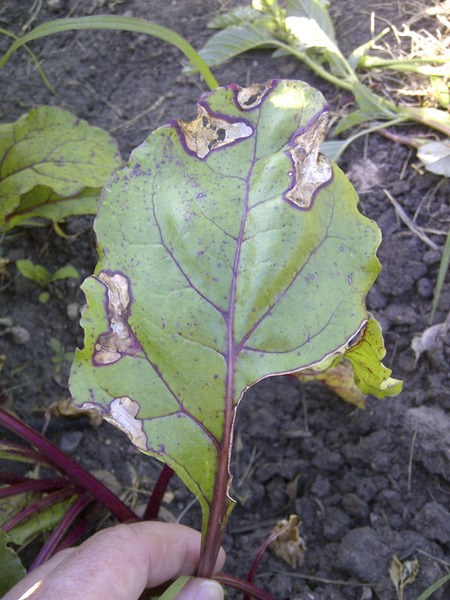Sonia, who has a neighbouring community garden plot to mine, remarked something was attacking her beet leaves upsetting her plans to include some in her bread. The cause is a common insect pest that attacks beets, spinach and Swiss chard, known alternately as beet leaf miner or spinach leaf miner. For many, damaged beet leaves are not a huge deal (Sonia doesn't agree), but for Swiss chard and spinach where the leaf is the edible part, leaf miner attack is not a minor issue.
The damage - initially small, irregular brown patches on the leaf but gradually growing in size and becoming papery, resembling a blister, with black pepper-like particles inside - is caused by small yellow or white larvae as they tunnel between the top and bottom leaf surfaces. They start out as small white eggs laid singly or in groups of two to 10 on the underside of the leaf by a small grey fly in late May. The eggs hatch within a week and the larvae chew their way through the leaf epidermis to start feeding. The larvae mature after one to two weeks and drop to the soil to burrow five to eight centimetres below the surface to then change into pupae. After two to four weeks of further development, adult flies emerge to start the cycle over again. There is usually more than one generation per year.
Every year, a few of my beet leaves are attacked, but not enough to be overly concerned. And Sonia doesn't really have many affected leaves either. But since the attack starts in May, small plants can be susceptible to attack and become stunted and weak under heavy infestations.
It is nearly impossible to control the adult stage, and once the larvae are tunneling through the leaf, there are likewise few control options as they are protected by the leaf surfaces. But there are a few ways to limit their numbers and impact. Start with good weed control. Beet leaf miner can complete its lifecycle on lamb's quarter, nightshade, chickweed and other weeds. Removing these hosts will limit their food source and reduce adults reaching maturity. Next, as soon as you notice damage, remove and destroy affected leaves before the larvae mature - do not compost. If you notice the damage later, after the larvae have dropped to the ground, you can disturb the soil around the plants in the hopes of damaging or exposing the pupae. After harvest and/or before planting, rototill the soil to expose the pupae to adverse environmental conditions and to birds that will gladly swoop down to consume them. If you have a large garden, move your beets, spinach or Swiss chard to a different location every year. Finally, start your crop early and optimize soil moisture and fertility to maximize plant size to reduce the overall impact of an attack.
Shirley's easy refrigerator beet pickle
If you like pickled beets but hate the mess of canning, here's a quick and easy recipe from my friend's mom.
Bring 2 cups sugar, 2 cups vinegar and 2 cups water to a gentle simmer. Stir until the sugar is dissolved. Remove from heat. Add 1 tablespoon each of whole allspice and whole cloves plus 2 or 3 sticks of cinnamon; steep at room temperature for 30 minutes. Pour over 6 to 8 cups of diced, cooked beets. Refrigerate. They will be ready to eat after two days. These beets will keep in the fridge for up to four weeks.
Have a gardening question? Contact GardenLine, 306-966-5865 or gardenline@usask.ca
- This column is provided courtesy of the Saskatchewan Perennial Society (www.saskperennial.ca; hortscene@yahoo.com). Check out our Bulletin Board or Calendar for upcoming horticulture events (Labour&Learn at the Forestry Farm; garden tours; garden book launches).



